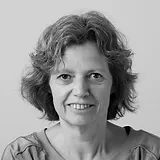
Anke van den Berg
prof. dr.
I work as a clinical molecular biologist in the department of Pathology. In this function I supervise and implement advanced molecular diagnostic techniques. Within my research line, I focus on the molecular pathogenesis of B-cell Hodgkin and non-Hodgkin lymphoma. The specific fields of interest are genomic aberrations, genetic susceptibility, and the role of small and long noncoding RNAs. I have several international collaborations and am PI and co-PI in various projects.
Long Noncoding RNA Expression Profiling in Normal B-Cell Subsets and Hodgkin Lymphoma Reveals Hodgkin and Reed-Sternberg Cell Specific Long Noncoding RNAs
Published in: The American Journal of Pathology
Access to document
10.1016/j.ajpath.2016.05.011
Hodgkin lymphoma (HL) is a malignancy of germinal center (GC) B-cell origin. To explore the role of long noncoding RNAs (lncRNAs) in HL, we studied LncRNA expression patterns in normal B-cell subsets, HL cell lines, and tissues. Naive and memory B cells showed a highly similar lncRNA expression pattern, distinct from GC-B cells. Significant differential expression between I-IL and normal GC-B cells was observed for 475 lncRNA loci. For two validated lncRNAs, an enhanced expression was observed in HL, diffuse large 6-cell lymphoma, and lymphoblastoid cell lines. For...
Mina Masoumeh Tayari, Melanie Winkle, Gertrud Kortman, Jantine Sietzema, Debora de Jong, Martijn Terpstra, Pieter Mestdagh, Frans G. M. Kroese, Lydia Visser, Arjan Diepstra, Klaas Kok, Anke van den Berg, Joost Kluiver
SETD2: an epigenetic modifier with tumor suppressor functionality
Published in: Oncotarget
Access to document
10.18632/oncotarget.9368
document
In the past decade important progress has been made in our understanding of the epigenetic regulatory machinery. It has become clear that genetic aberrations in multiple epigenetic modifier proteins are associated with various types of cancer. Moreover, targeting the epigenome has emerged as a novel tool to treat cancer patients. Recently, the first drugs have been reported that specifically target SETD2-negative tumors. In this review we discuss the studies on the associated protein, Set domain containing 2 (SETD2), a histone modifier for which mutations have only recently been...
Functional Studies on Primary Tubular Epithelial Cells Indicate a Tumor Suppressor Role of SETD2 in Clear Cell Renal Cell Carcinoma
Published in: Neoplasia
Access to document
10.1016/j.neo.2016.04.005
document
SET domain-containing 2 (SETD2) is responsible for the trimethylation of histone H3 lysine36 (H3K36me3) and is one of the genes most frequently mutated in clear cell renal cell carcinoma (ccRCC). It is located at 3p21, one copy of which is lost in the majority of ccRCC tumors, suggesting that SETD2 might function as a tumor suppressor gene. However, the manner in which loss of SETD2 contributes to ccRCC development has not been studied in renal primary tubular epithelial cells (PTECs). Therefore, we studied the consequences of SETD2 knockdown...
Jun Li, Joost Kluiver, Jan Osinga, Helga Westers, Maaike B. van Werkhoven, Marc A. Seelen, Rolf H. Sijmons, Anke van den Berg, Klaas Kok
Meta-analysis of genome-wide association studies reveals genetic overlap between Hodgkin lymphoma and multiple sclerosis
Published in: International Journal of Epidemiology
Access to document
10.1093/ije/dyv364
document
Background: Based on epidemiological commonalities, multiple sclerosis (MS) and Hodgkin lymphoma (HL), two clinically distinct conditions, have long been suspected to be aetiologically related. MS and HL occur in roughly the same age groups, both are associated with Epstein-Barr virus infection and ultraviolet (UV) light exposure, and they cluster mutually in families (though not in individuals). We speculated if in addition to sharing environmental risk factors, MS and HL were also genetically related. Using data from genome-wide association studies (GWAS) of 1816 HL patients, 9772 MS patients and...
Pouya Khankhanian, Wendy Cozen, Daniel S. Himmelstein, Lohith Madireddy, Lennox Din, Anke van den Berg, Takuya Matsushita, Sally L. Glaser, Jayaji M. More, Karin E. Smedby, Sergio E. Baranzini, Thomas M. Mack, Antoine Lizee, Silvia de Sanjose, Pierre-Antoine Gourraud, Alexandra Nieters, Stephen L. Hauser, Pierluigi Cocco, Marc Maynadie, Lenka ForetovaAnthony Staines, Manon Delahaye-Sourdeix, Dalin Li, Smita Bhatia, Mads Melbye, Kenan Onel, Ruth Jarrett, James D. McKay, Jorge R. Oksenberg, Henrik Hjalgrim
Single-cell sequencing reveals karyotype heterogeneity in murine and human malignancies
Published in: Genome Biology
Access to document
10.1186/s13059-016-0971-7
document
Background: Chromosome instability leads to aneuploidy, a state in which cells have abnormal numbers of chromosomes, and is found in two out of three cancers. In a chromosomal instable p53 deficient mouse model with accelerated lymphomagenesis, we previously observed whole chromosome copy number changes affecting all lymphoma cells. This suggests that chromosome instability is somehow suppressed in the aneuploid lymphomas or that selection for frequently lost/gained chromosomes out-competes the CIN-imposed mis-segregation. Results: To distinguish between these explanations and to examine karyotype dynamics in chromosome instable lymphoma, we use...
Bjorn Bakker, Aaron Taudt, Mirjam E. Belderbos, David Porubsky, Diana C. J. Spierings, Tristan V. de Jong, Nancy Halsema, Hinke G. Kazemier, Karina Hoekstra-Wakker, Allan Bradley, Eveline S. J. M. de Bont, Anke van den Berg, Victor Guryev, Peter M. Lansdorp, Maria Colome-Tatche, Floris Foijer
